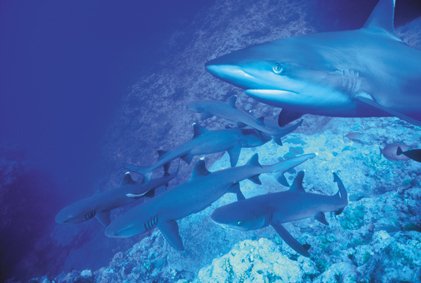Sharks and Rays
Sure, There Are Some Similarities—But Do They Really Share an Ancient Aunt?
Originally published in Creation 24, no 4 (September 2002): 28-32.
One cruises through the water like a heat-seeking missile, the other swims gracefully like a giant bird in slow motion. They are the shark and the ray.
The class they share is called Chondrichthyes because their skeletons are made of cartilage, not bone (Greek chondros = cartilage, ichthys = fish).

Gary Bell © www.oceanwideimages.com
Aside from their skeletons, the members of the Chondrichthyes class also share other physiological and biochemical “peculiarities.” In many species the young hatch from eggs inside the female body and are “born” alive. Also, they use a unique method of retaining the chemical urea in order to maintain the internal balance of body chemicals in their salty environment.1
This is why many evolutionary biologists claim the two types of marine creatures evolved from a common (i.e. the same) ancestor that had all those features. However, there are also many differences that continue to cause problems for this view. Aside from the obvious differences in appearance between sharks and rays, they also use different methods to breathe, and different ways of moving through the water.
The shark breathes by drawing in water through its mouth, passing it over the gills and ejecting it through slits. But this method wouldn’t work for rays, because many are bottom-dwellers and they would end up drawing in water full of sand, mud and grit. Instead, rays have an opening (called a spiracle) behind each eye on the top of their head, which draws in clean water and takes it straight to the gills. It is then ejected through gill-slits on the ray’s underside.2
The sting in the tail

Gary Bell ©
www.oceanwideimages.com
-
Injuries to humans from stingrays tend to occur when an unsuspecting person steps on a ray, causing the creature to reflexively strike out with its tail.
-
The tail is thrust into the victim, usually in the foot or lower leg, producing a deep, jagged laceration from the serrated spine.
-
The stinger apparatus then injects a protein-based toxin into the wound, causing immediate intense pain in the victim.3
-
Resultant wounds produce sharp, shooting, throbbing pain. The toxin can also produce a fall in blood pressure, nausea, vomiting, cardiac failure and muscular paralysis. There is no known antidote; however, death in humans is rare.4
The issue of a common ancestor for sharks and rays becomes even more complicated when the variations between their own species are considered. (There are 200 to 250 species of sharks and 300 to 340 species of rays.5)
Sharks come in all shapes and sizes, and all have incredible design features suiting their diet and environment. Those that feed near the surface, like the Mako and Thresher Sharks, are beautifully streamlined and powerful swimmers, allowing them to catch and feed on fast tuna and marlin. Bottom-feeding shark species are stout, blunt-headed and more sluggish, while shellfish-eaters have coarse, pavement-like crushing teeth.6
Rays are typically categorized as either electric rays, sawfishes, skates, or as members of one of the various families that have slender, whip-like tails equipped with spines (generally referred to as “stingrays”). Some have scales like a shark, some do not. Some give birth to live young, some do not.
Rays have flattened disk-like bodies with five gill exit openings and their mouth generally located on their underside. They have large pectoral fins, which they move like wings to travel in the water, and their tails are generally long and slender, with many species having one or more sharp, venomous spines that can be used to inflict painful wounds. Rays range in width from 25 cm (10 in) in the north-western Atlantic species to 2 m (7 ft)—and up to 4 m in length—in Australian species.7
Some rays are bottom-dwellers, like the stingray. These rays often lie partially buried in the shallows, eating worms, mollusks and other invertebrates.8 Others use their broad pectoral fins to dig shellfish from the sand or mud.9
Manta Rays, on the other hand, swim near the surface. Mantas are the largest of all rays and use a very distinctive “flapping” motion to swim. They are known to leap clear out of the water—possibly to remove parasites, or just for fun.10 They feed by moving through masses of macroplankton or schools of small fish, turning slowly from side to side and using their prominent front “cephalic” fins to fan prey into their broad mouth.11
Hoo-ray for elasmobranchs12

Gary Bell ©
www.oceanwideimages.com
- Since ancient times, Chinese people have used the dorsal fins of certain sharks and rays as the basis of epicurean soup.
- Shark liver oil is used in various regions for tanning leather; preserving wood; as a lubricant; as folk medicine against rheumatism, burns and coughs; as a general tonic; as a laxative; and as an ingredient of cosmetics.
- About 110,000 tonnes of rays are marketed for food annually in various countries around the world, principally in Europe and Asia.
- Byproducts of rays include skins of scaleless species for drumheads; those of scaly species are used for shagreen (a type of leather).
- Ray livers are used for oil, ray fins for gelatin.
- People from many tropical regions—Polynesia, Oceania, Malaysia, Central America and Africa—have used the spines of stingrays for such items as needles and awls, spear tips and daggers, and for the poison they contain.
- The entire tails of stingrays have been used as whips in various tropical locations.
One of the most amazing species of ray is the Electric Ray (also called “torpedo”), which has large paired electric organs between its pectoral fins and its head, used to give a powerful shock for either defensive purposes or to kill prey.
This is an incredibly complex design feature. It involves delivery of electricity by timing the nervous impulses that activate individual cells capable of producing electrical currents (called electroplaques).13 The Electric Ray is a bottom-dweller that feeds on invertebrates and fish. With its widely extensible jaws, combined with its electricity, this typically sluggish ray is able to catch very active fish such as flounder, eel, salmon and dog-fish.14
Interestingly, the ancient Greeks and Romans used the electric shock of this particular ray to treat diseases of the spleen, chronic headaches and gout. The word “narcotic,” used to describe powerful pain-relievers, comes from the Greek word for Electric Ray, narke.15
The discovery of a new type of deep-water ray, Hexatrygon bickelli, off the coast of South Africa in 1981, indicated the possible existence of another entire stingray family. The specimen possessed unique design features suited to deep-water life, and was classified by its discoverers in a separate family and suborder. If such a totally new category is confirmed, it will cause even more complications for those trying to determine an evolutionary history for the ray.
Because rays and sharks are cartilaginous fishes, their skeletons do not generally fossilize in the same way as those of bony fishes. However, their teeth and scales have fossilized, and those in the fossil record tend to indicate that the “ancient” ancestors of the cartilaginous fishes were little different from those of today.16
Evolutionists have no idea how sharks and rays evolved, either in their own class or in the broader scheme of marine evolution. They say bony and cartilaginous fishes evolved independently, “although the lines of evolution remain to be discovered.”17

Gary Bell ©
www.oceanwideimages.com

Even the relationship between members of the Chondrichthyes class is not without ongoing debate. The New Encyclopaedia Britannica admits that the relationship of sharks, rays and chimaeras (see description below) is subject to “varying interpretation”:
“Although both groups have many characteristics in common, such as the possession of a cartilaginous skeleton … the two groups may have evolved independently along parallel lines … .”18
This idea of “parallel evolution” is often invoked by evolutionists to explain amazing similarities which, for other reasons, could not have come about through sharing a common ancestor. The obvious explanation for such similarities, design by the same Designer, is “not allowed.”
However, it is difficult enough to accept that, through blind chance filtered by selection (ultimately in a chance succession of environments), a species could develop specialized features such as a skeleton of cartilage and the ability for young to hatch from eggs inside the female’s body.
The concept that such features could independently evolve in species with no connection to each other—again relying on blind chance—is not only illogical, but without evidence.
Evolution-believers try to have it “both ways”—shared design features are used to “prove” common descent, but when this doesn’t work for other reasons, why, there is always “parallel evolution” to fall back on.
The other theory, that the similarities between sharks and rays came about because these were possessed by a common ancestor, is also totally without evidence. There has been no find in the fossil record to indicate such a creature ever existed. In fact, the fossil evidence indicates that sharks and rays have always been sharks and rays.
The alternative explanation, that they were created as fully-formed, separate kinds by God, seems a much more reasonable one. Although we do not know for sure how many kinds of each were initially created (perhaps only a very few, with great variety possible within each kind, as seen in other organisms), the creation explanation is consistent with the evidence.
Beginner’s Guide to rays and their like
| Chondrichthyes: | The class in which sharks and rays are classified. |
| Elasmobranch: | The subclass of Chondrichthyes in which sharks and rays are classified. |
| Chimera: | A member of the Chondrichthyes, but in a separate subclass to sharks and rays. Also known as the “ghost shark”. It has a single gill opening, covered by a flap, as in bony fishes, on each side of the body. (Also spelt chimaera.) |
| Stingray: | Any species of ray with the traditional disk-shaped body and long, whip-like tail with barbed spine. |
| Skate: | Not a “true” ray. It has large pectoral fins extending from the snout and stopping at the tail. Unlike other rays, its young emerge from eggs outside the body. The skate does not have the long, slender barbed spine that distinguishes stingrays. |
| Sawfish: | Another type of ray, with rough skin and strong spine. It has a snout which is a long blade with a series of strong teeth. |
| Eagle Ray: | This bottom-dweller is different from traditional stingrays as it has a more identifiable head and pronounced snout. |
| Manta Ray: | The largest of the rays, it can grow to a wingspan of more than 7 m (23 ft). It is identifiable by the “cephalic fins” extending from the eyes. |
| Freshwater stingray: | This species looks similar to the marine stingray, with circular disk body, marked with spots. Its slender tail is armed with a serrated, stinging spine. It eats worms, crustaceans and mollusks. |
Footnotes
- The New Encyclopaedia Britannica, 15th edition, 19:212, 1992.
- Sharks and rays: fish with no ancestors, Creation 14(3):51, 1992.
- Medicine—Stingray Envenomations, <www.emedicine.com/EMERG/topic556.htm>, 20 February 2002.
- The New Encyclopaedia Britannica, 15th edition, 25:926, 1992.
- Ref. 1, p. 208. The imprecision is because some authorities tend to “lump” while others “split”.
- Ref. 1, 10:702.
- Ref. 1, 11:273.
- Ref. 1, 11:273.
- Ref. 1, p. 210.
- Cayman.org—Manta Ray, <www.cayman.org/fauna/manta.htm>, 20 February 2002.
- Ref. 1, p. 210.
- All information in this section from The New Encyclopaedia Britannica, 15th edition, 19:208–209, 1992.
- Encyclopaedia Britannica 2002 (CD), article: “bioelectricity”.
- Ref. 1, p. 210.
- Ref. 1, p. 209.
- Sharks and rays: fish with no ancestors, Creation 14(3):51, 1992.
- Ref. 1, p. 209.
- The New Encyclopaedia Britannica, 15th edition, 19:212, 1992.

Answers in Genesis is an apologetics ministry, dedicated to helping Christians defend their faith and proclaim the good news of Jesus Christ.
- © 2025 Answers in Genesis

